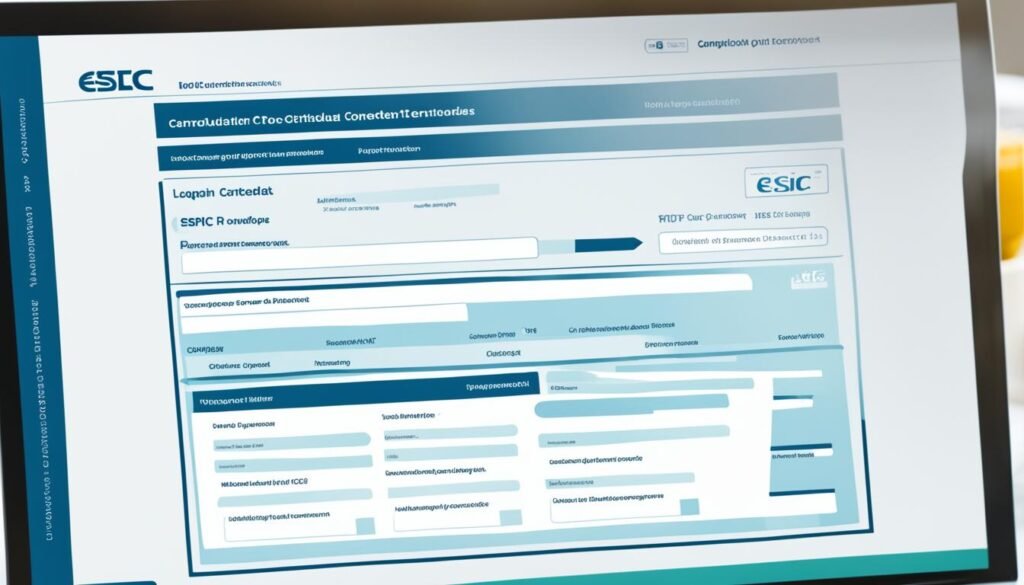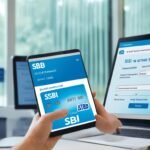The ESIC Scheme in India provides employers with a convenient online portal for making payments and ensuring compliance with timely contributions. Employers can remit monthly contributions through the ESIC portal, which is accessible to SBI account holders with net banking facilities. It is important to note that the ESIC contribution rates were reduced starting from July 1, 2019.
Key Takeaways:
- ESIC payment is made through the online portal, accessible to SBI account holders with net banking facilities.
- ESIC contribution rates were reduced from July 1, 2019.
- Employers must ensure timely payments to comply with ESIC regulations.
- The ESIC portal provides a convenient platform for making payments and checking payment statuses.
- ESIC registration and adherence to the wage ceiling are essential for availing benefits under the scheme.
ESIC Portal Login and Monthly Contribution Filing
To access the ESIC portal, employers need to visit www.esic.in and log in using their ESIC user ID and password. Once logged in, employers will be directed to a page with hyperlinks for different modules.
To file monthly contributions, employers can use the “Online Monthly Contribution Screen” where they can manually enter the contribution details for each employee or upload an excel file for bulk upload. After submitting the contribution details, employers can proceed to make the online payment through SBI net banking.
Here’s a step-by-step guide:
- Go to www.esic.in.
- Enter your ESIC user ID and password.
- Click on the “Login” button.
- You will be directed to the ESIC portal main page.
- Click on the “Online Monthly Contribution Screen” link.
- In the contribution screen, manually enter the details for each employee or upload an excel file for bulk upload.
- Double-check the contribution details for accuracy.
- Click on the “Submit” button to save the contribution details.
- After the contribution details are saved, click on the “Make Payment” button.
- You will be redirected to the SBI net banking page for online payment.
By following these steps, employers can easily log in to the ESIC portal and file their monthly contributions in a hassle-free manner. The online filing system provides a convenient and efficient way to ensure compliance with ESIC regulations.
The ESIC portal makes it easy for employers to login and file their monthly contributions. The user-friendly interface allows for manual entry or bulk upload of contribution details, streamlining the process for busy employers.” -ESIC Guide

| Benefits | Features |
|---|---|
| Easy access to the ESIC portal | Simple and user-friendly interface |
| Options for manual entry or bulk upload | Convenient online payment through SBI net banking |
| Timely filing of monthly contributions | Ensures compliance with ESIC regulations |
How to Generate and Reprint ESIC Challan Online
Employers can easily generate and reprint their ESIC challans online through the ESIC portal. Follow these steps to complete the process:
Generate ESIC Challan:
- Log in to the ESIC portal using your credentials.
- Click on the “Generate Challan” link.
- Select the record for which the payment needs to be made.
- Enter the payment amount.
- Submit the details.
- Choose the online payment option to proceed with the payment.
Reprint ESIC Challan:
- Visit the “Challan Double Verification” page.
- Enter the employer’s code number and challan number.
- Download the challan using the provided option.
This simple process allows employers to efficiently generate and reprint their ESIC challans, ensuring smooth payment transactions and compliance with ESIC regulations.
Note: The image above highlights the ESIC challan generation and reprinting process.
Important Points for Successful ESIC Payment
Timely payment of ESIC contributions is vital for employers to avoid penalties. The payment due date for ESIC contributions is the 15th of every month. Ensuring prompt payment is essential to comply with regulations and provide financial security for employees.
In the unfortunate event of a transaction failure during the payment process, employers can utilize the “Online Challan Double” link to reprocess the transaction. This can be done by entering the challan number to initiate the payment once again.
Transaction failures can occur due to various reasons, such as connectivity issues, insufficient funds, or the employer forgetting their login credentials. It is important to verify and address these issues to ensure a successful payment.
Additionally, employers should be aware of any potential issues with the ESIC site redirecting to the SBI payment page. Regularly monitoring the functionality and performance of the ESIC site can help identify and promptly address any site-related issues that may affect the payment process.
By prioritizing timely payment, addressing transaction failures, and staying vigilant for any ESIC site issues, employers can ensure the smooth processing of ESIC payments and maintain compliance with ESIC regulations.
ESIC Payment for Various Allowances and Bonus
The ESIC payment system encompasses a wide range of allowances and bonus payments that employers need to factor in while calculating and disbursing employee benefits. These additional components further enhance the overall compensation package provided by employers. It’s crucial for employers to accurately calculate and include these allowances and bonuses in the ESIC payments to ensure compliance with ESIC regulations.
Below is a comprehensive list of the various allowances and bonus payments that should be considered while making ESIC payments:
- Washing Allowance: This allowance covers the expenses incurred by employees for washing their uniforms or work-related clothing.
- Suspension Allowance: This allowance is paid to employees who have been temporarily suspended from work pending an investigation or disciplinary action.
- Overtime Allowance: Employees who work beyond their regular working hours are entitled to overtime pay, which should be included in the ESIC payment.
- Annual Bonus: Employers often provide an annual bonus as a form of appreciation for employees’ hard work and dedication throughout the year.
- Incentive Bonus: Incentive bonuses are performance-based payments given to employees as a reward for achieving specific targets or goals.
- Production Bonus: This bonus is provided to employees who contribute significantly to the production output of the organization.
- Inam Payment: Inam payments are additional financial rewards given to employees in recognition of exceptional performance or achievements.
- Wages During Layoff: When employees are temporarily laid off due to unfavorable business conditions, they may be entitled to a certain percentage of their wages.
- Annual Commission: Employees working in sales or commission-based roles are eligible for an annual commission, which should be included in the ESIC payment.
- House Rent Allowance: This allowance compensates employees for the expenses incurred on renting accommodation for their residential purposes.
- Night Shift Allowance: Employees who work night shifts are often entitled to an additional allowance to compensate for the inconvenience and additional effort.
- Conveyance Allowance: Conveyance allowance reimburses employees for transportation expenses incurred while commuting to and from work.
- Service Charges: Service charges refer to payments made by customers for availing certain services, and the employees involved in delivering those services may receive a share of these charges as an allowance.
Employers must familiarize themselves with the guidelines and specific rules related to these allowances and bonuses to ensure accurate and compliant ESIC payments.
Providing employees with a comprehensive compensation package that includes these various allowances and bonuses not only helps attract and retain top talent but also fosters a positive work environment and motivation among employees.
For a better understanding, let’s take a look at the table below, which summarizes the key allowances and bonuses that should be included in ESIC payments:
| Allowances and Bonuses | Description |
|---|---|
| Washing Allowance | Expense coverage for washing uniforms or work-related clothing |
| Suspension Allowance | Payment during temporary suspension from work |
| Overtime Allowance | Additional pay for working beyond regular working hours |
| Annual Bonus | Yearly reward for employees’ hard work and dedication |
| Incentive Bonus | Performance-based payment for achieving specific targets or goals |
| Production Bonus | Bonus for employees contributing significantly to production output |
| Inam Payment | Additional financial reward for exceptional performance or achievements |
| Wages During Layoff | Partial payment during temporary layoff |
| Annual Commission | Commission-based payment on an annual basis |
| House Rent Allowance | Allowance for residential accommodation expenses |
| Night Shift Allowance | Allowance for working night shifts |
| Conveyance Allowance | Reimbursement for transportation expenses |
| Service Charges | Share of payment received from customers as an allowance |

Conclusion
In conclusion, the ESIC payment process can be easily managed through the online portal provided by the ESIC. Employers must prioritize timely contributions and ensure compliance with ESIC regulations to provide seamless services to both employers and employees. By following the steps outlined in this ESIC payment guide, employers can simplify the ESIC payment process and avoid any penalties or delays.
Ensuring timely contributions is essential to meet the 15th of every month deadline and avoid penalties. Employers should be aware of transaction failures and the common reasons behind them, such as connectivity issues, insufficient funds, or forgotten login credentials. Additionally, employers should stay updated on any issues with the ESIC site redirecting to the SBI payment page.
It is important to include various allowances and bonus payments in the ESIC payment calculation. Washing allowance, suspension allowance, overtime allowance, annual bonus, incentive bonus, production bonus, inam payment, wages during layoff, annual commission, house rent allowance, night shift allowance, conveyance allowance, and service charges should all be considered. Employers must adhere to ESIC regulations to ensure accurate and compliant ESIC payment calculations.
FAQ
What is the ESIC portal and how do I login?
The ESIC portal is an online platform for employers in India to make ESIC payments and ensure compliance. To login, visit www.esic.in and enter your ESIC user ID and password.
How do I file monthly contributions through the ESIC portal?
After logging in to the ESIC portal, click on the “Online Monthly Contribution Screen” link. You can manually enter the contribution details for each employee or upload an excel file for bulk upload.
How can I generate and reprint ESIC challans online?
To generate a new challan, click on the “Generate Challan” link in the ESIC portal. Select the record for which the payment is to be made, enter the payment amount, and choose the online payment option. To reprint a challan, visit the “Challan Double Verification” page, enter the employer’s code number and challan number, and download the challan.
What is the due date for ESIC contribution payment?
The due date for ESIC contribution payment is the 15th of every month. It is important to ensure timely payment to avoid penalties.
What should I do if the transaction fails?
If the transaction fails, you can use the “Online Challan Double” link to process the transaction again by entering the challan number. Common reasons for transaction failure include connectivity issues, funds shortage, or forgetting login credentials.
What payments should be included in the ESIC payment?
The ESIC payment should include various allowances and bonus payments such as washing allowance, suspension allowance, overtime allowance, annual bonus, incentive bonus, production bonus, inam payment, wages during layoff, annual commission, house rent allowance, night shift allowance, conveyance allowance, and service charges. Employers should ensure compliance with ESIC regulations regarding these payments.





